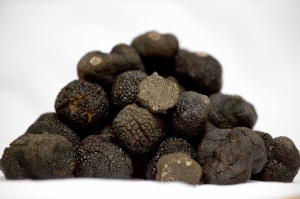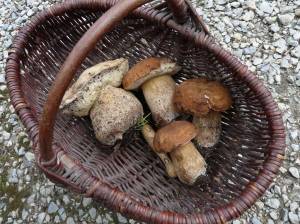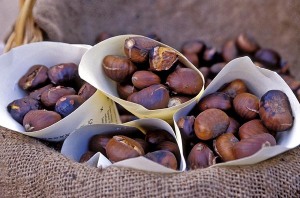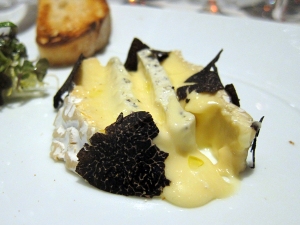Being in this amazing food-rich area where regional loyalty towards its products is somewhat feverish, food just tastes different. It’s walnut harvesting time here, and we see these amazing sweeping/sucking machines gathering the nuts from under the lanes of stately trees, which results in the grass being soft, green and nicely combed after each sweeping. With the dappled autumn light coming through the slowly dropping leaves, it all looks amazing. I’ve grown up with walnuts being foisted upon me as cheap and readily sourced snack food (walnuts and Vegemite sandwiches for school lunches, for Pete’s sake). I tolerated them but that’s all, and mostly I didn't really even like them. But here, now, they taste fabulous. Our gite hosts gave us a basket of locally gathered walnuts on our arrival, and we all tucked into them with great pleasure. Since then, we’ve also bought a walnut apéritif, a walnut and cassis apéritif, a walnut oil for salads, and croquants aux noix du Périgord (crunchy sugary egg-y walnut-y biscuits).
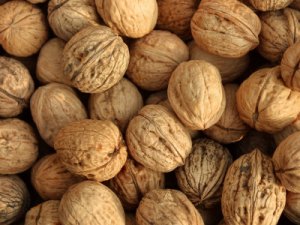
We’ve now eaten meals with various local Dordogne ingredients, including: truffles, chestnuts (oh more yum!), foie gras (the kids for lunch), cèpe mushrooms, confit de canard, aiguillettes de canard (strips of tender duck breast – the kids for lunch again), and Bergerac red wine. We visited a gourmet food filled shop yesterday in Domme and were treated to tastes of different apéritifs, and those crunchy biscuits. The manager was large, accommodating and lovely, and I’d recommend a visit there (top of the main street, opposite the Office du Tourisme). The views from Domme would have been amazing, had it not been for the fog! After lunch and once the fog cleared, we also saw wild, side of the road apple trees, laden with sun/tree ripened fruit (so delicious if you are able to ignore the creatures that like apples too), and dozens of wild fig trees, that had obviously been laden in their earlier peak time. I want to live there!
Our friend from the Dordogne, Pascal, said he would walk 500 miles for the taste of some good cèpe mushrooms, and I agree. At a frightfully posh restaurant in Sorges I really enjoyed salmon with cèpe mushroom sauce, plus a side dish of broad beans, parsnips, chestnuts, artichokes, purple potato, and carrot. Delish. (How did they know that broad beans, parsnips, chestnuts and artichokes are some of my all-time-favourite foods?!) Lovely husband had a truffle omelette, which is apparently one of the best ways to ‘carry’ the truffle flavour. It was soft and melty.
And as for chestnuts, I grew up gathering chestnuts with my sisters from our small-town neighbourhood, and they were the best treat on a cold winter’s night, heated in a beaten old lidded pan over our open fire in the living room, and, before they exploded, eaten quickly off spread-out newspaper. We would all end up with blackened and singed fingers but it was worth it. In France in the winter time you will often find street vendors roasting chestnuts, and the aroma is wonderful. You can buy un cornet de châtaignes (a twisted roll of paper filled with roasted chestnuts) from the vendor, and walk on your happy way munching them. I’m not sure there’s anything better; except, perhaps, if you’ve got a glass of vin chaud (hot red wine) in your hand too.
And incidentally, Pascal-from-the-Dordogne’s-wife, Marie, had us to dinner at their house recently. I’m going to write more about that meal another time because the food was just soooo good, but for now a little aside to say that her duck and cèpe mushroom with pureed chestnut topping for the main course was simply heaven and very ‘Dordogne’. In my opinion she is quite seriously practically a multiple-starred chef, working at IKEA and living quietly in Muret. For the cheese course Marie had bought a nice selection, including brie with a layer of truffles. I absolutely love(d) it.
This afternoon we visited the Maugein accordion factory in Tulle. My husband couldn’t contain his excitement. It was a real factory with real workers, fabricating everything on site and to unique specifications, and not in China! The tour was free, the sights were special. Nothing to eat there though but enough beautifully crafted squeeze-boxes to keep us happy for a lifetime.
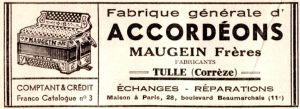
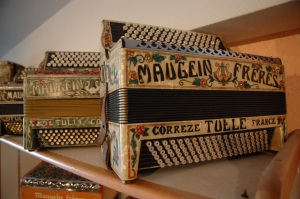
© Sara Crompton Meade 2013
